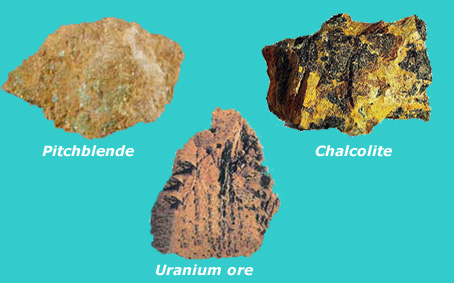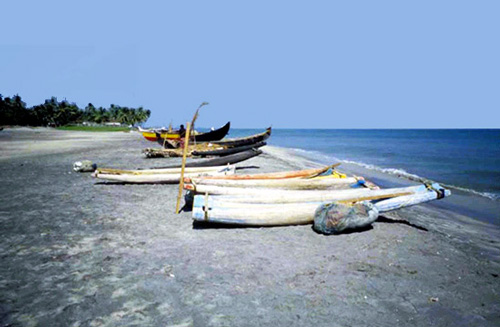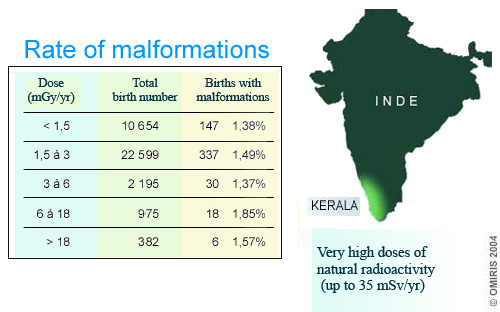Telluric Exposure : Radiation which emanates from rocks

Radioactive minerals
Minerals containing thorium, uranium or any of their descendants can be considered to be slightly radioactive, the main exposure resulting from the gamma rays which escape from the rock. Pitchblende and chalcolite, shown above, are two of the minerals which have played an important role in the discovery of radioactivity. Uranium is a very rare element, and uranium ores rarely contain more than a few percent of it. It is present in much smaller amounts in rocks such as granite.
© IN2P3
The Earth crust contains a number of radioisotopes which are the principal natural sources of radioactivity: thorium 232, uranium 235 and uranium 238. With half-lives stretching out into the billions of years, none of them are even close to disappearing and for that reason are still key elements in our environment.
Along with their respective radioactive lineages, these three radioisotopes cause what is known as ‘telluric’ radiation, the natural radioactivity of rocks. These telluric radiations are a key external low source of gamma radiation, both inside and outside of buildings. The presence of these radioisotopes in the building materials may cause the levels of radiation indoors to be greater than those found outside. Whereas buildings made from wood do not have this problem, the downside is that wood acts as a poor shield from the gamma radiation coming from the soil.
In a country such as France, the average annual exposure from telluric radiation can be estimated at around 0.5 mSv. The estimation assumes humans spend in average 80% of their time indoors and 20% outdoors.

The radioactive sands of Kerala
The emission of gamma rays by thorium and its descendants leads to an exposure which varies from place to place. Studies have shown that the radioactivity of the black sands of Kerala may have accelerated the DNA mutations of the local population. However, most of these mutations would be the same as those that have occurred during the last 60,000 years of human evolution.
© DR
In the granite-rich areas of Brittany, where the rocks contain higher doses of radioactive elements, the exposure can be four times as high. Even then, however, the numbers are insignificant when compared to the doses absorbed on the black sand beaches of Brazil or Southern India, where the abundant mineral monazite consists of almost 10% radioactive thorium.
The world’s highest background radiation rate is found in the city of Ramsar in Iran, with the astonishing maximum near a volcanic hot spring of 250 millisieverts a year. An iranian publication in 2002, indicates that Cytogenetic studies show no significant differences between people in the high background areas compared to people in normal background areas.
The study of the consequences of this natural radioactivity on certain communities in Southern India has not shown increase in the mortality rate, although certain chromosomal mutations have been observed. In any case, the analyses that have been carried out are not precise enough to be conclusive.

Study of malformations (South India)
In the exposed communities in Southern India, where the exposition to natural radioactivity is high (from 1 to more than 35 msV/an), the percentages of deformities and stillbirths do not seem to be linked with the levels of telluric radiation, as these rates do not appear to change with increasing doses of radiation. In addition, the number of births in the most exposed communities (which absorb over 6 mGy per person per year) is too small for any significant statistical correlation to be established.
© Omiris 2004
To the natural radioactivity emanating from ground, one should add the radioactive deposits coming from 1960s nuclear tests and the 1986 and 2011 Chernobyl and Fukushima accidents. The main emanation is that of the cesium-137 gamma rays. The contribution of nuclear tests spreadover the whole Eearth are now weak, while that of the Chernobyl and Fukushima accidents remains high near the sites.
Other articles on the subject « Natural Radioactivity »
Natural Origins
From vestiges of earth formation to cosmic rays Despite having evolved under constant exposure to[...]
Uranium and thorium origins
Radioactive substances older than the Earth The principal source of natural radiations on Earth i[...]
Cosmogenic Radioelements
Formation of radioactive atoms from cosmic rays The Earth is constantly being bombarded by &lsquo[...]
Natural Exposure
A chronic but benign exposure All exposure to radioactivity, whether natural or artificial, is me[...]
Human Internal Exposure
Our bodies are also… slightly radioactive All through our lives, we inhale and ingest radio[...]
Radioactivity in food
In our glasses and on our plates … The very acts of breathing and walking around make it im[...]